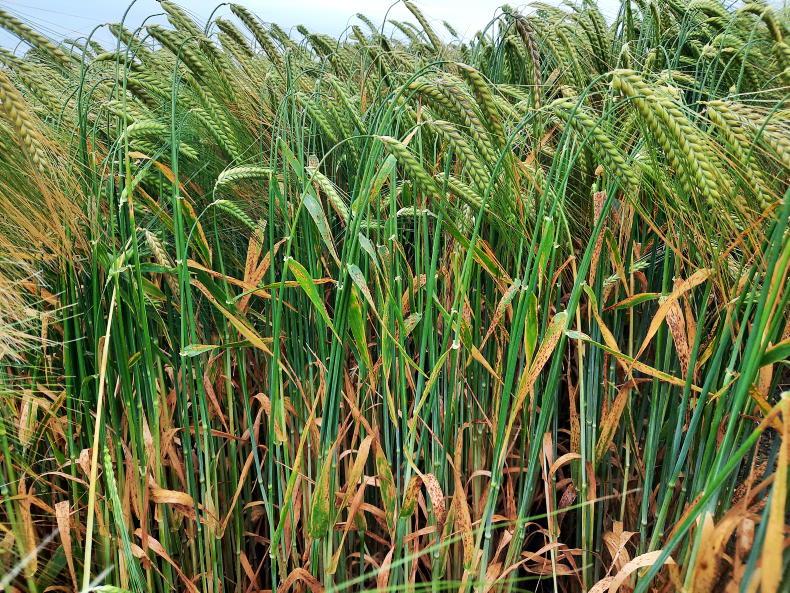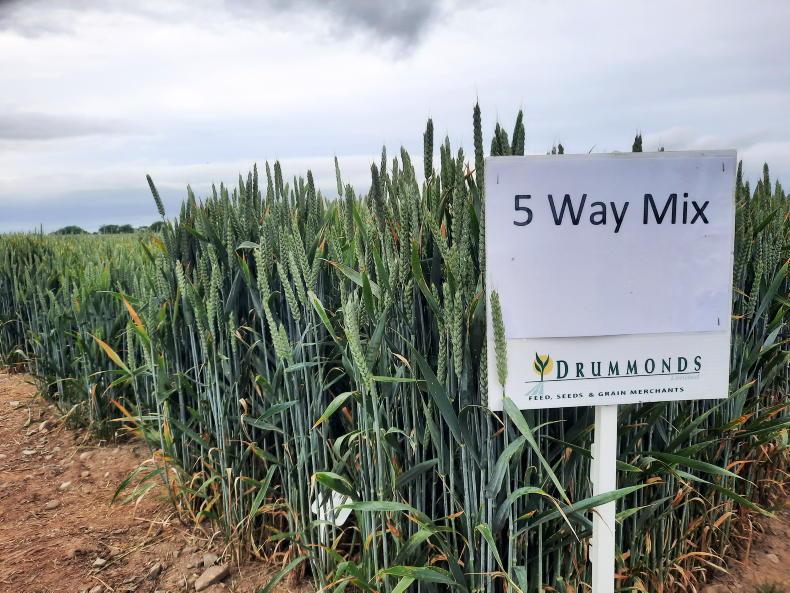Single varieties of crops grown on large areas provide maximum opportunity for selection of pests and diseases that can adapt to the variety being grown.
Even where multiple varieties are grown across a farm, they may carry the same resistance genes, so appear identical to the pest or pathogen.
To avoid, or reduce these problems, we need to introduce and manage diversity in better ways; one of these ways is by using a variety blend.
The rationale behind growing a variety blend is straightforward, with the blend having the potential to combine different genetic resources in the same crop, each of which might respond differently to stress, through contrasting levels of resistance or tolerance.
In the 1980s, the practice of growing blends of cereal varieties was common throughout the UK, with the seed merchant Sinclair McGill carrying out much trialling and marketing seed mixes, and even a world record achieved in 1994 in Fife, Scotland, with both wheat and barley variety blends.
This practice faded away, largely due to developments in the cereal supply chain that is today built around the traceability, provenance and consistent quality of uniform varieties.
Today, many farmers are re-exploring cereal blends to tackle pest, disease and weed threats and reduce inputs on their farms.

Mixed variety trials at the Drummonds trial site in Co Louth.
A variety blend acts as a portfolio diversifier and an insurance policy. It may not necessarily be the top-yielder on-farm, but it can provide stability by buffering against environmental stress and variation.
While farmers might not see an economic advantage in every season, they should across seasons.
Disease management
From a disease management perspective, the concept behind using a variety blend has two elements.
Firstly, it slows down disease development and inoculum buildup; that should bring us to a situation where we have less need for fungicide input. The second element is that we are disrupting selection pressure on both varietal genetics and fungicides by making it harder for the pathogen to move through the crop.
Feed wheats are the easiest place to start, as milling and wheat blends are more complex from an end-user acceptance point of view.
In NIAB membership trials, we have been looking at blends from a milling and soft wheat perspective, as well as feed wheat, in a three-year trial evaluating variety blends for yield, quality, disease and economic return.
We put together four milling wheat varieties and three group three soft varieties and compared the blends of each with the individual varieties grown as a straight.

Mixed variety trials at the Drummonds trial site in Co Louth.
The trial included three fungicide programmes; an untreated, a reduced rate fungicide programme of a third dose of Revystar XE (fluxapyroxad + mefentrifluconazole) at T1 and Univoq (fenpicoxamid and prothioconazole) at T2, respectively, and a full fungicide programme based on a typical farm standard programme for the season (tebuconazole at T0, Revystar XE at T1, Univoq at T2 and tebuconazole at T3).
We saw up to a 24% reduction in septoria in the three-way soft wheat variety blend under moderate disease pressure, with the biggest reduction in the untreated and the smallest in the full fungicide programme, unsurprisingly.
But the most notable effect was on yellow rust; managing a variety like KWS Zyatt or Skyfall – which has desirable milling qualities but yellow rust resistance ratings of just three on the UK recommended list – is possible in high yellow rust pressure years using a well-timed fungicide programme.

A six-way mix of winter barley at the Drummonds trial site in Co Louth.
However, in the reduced rate fungicide and untreated plots, it was clear both visually and in the resulting yield and quality data that growing these in a blend kept the disease at bay for up to six weeks after the traditional T2 timing.
It buys you what you don’t often have with yellow rust; time, by helping to reduce inoculum, delay an epidemic and get the best use out of fungicides in that crop.
The message we’re trying to get across with variety blends is that it’s not one management strategy over the other. It’s about using all the tools available to you in an integrated programme.
Blends in the supply chain
Growing a blend might be attractive to a farmer, but there’s no doubt that blends are disruptive to the rest of the supply chain; from breeding, to agronomy, seed certification, grain processing and end-user acceptability, but this in turn is creating opportunities for innovators to consider different approaches.
Seed companies face technical and logistical problems in supplying blends in sufficient volumes to make a large impact on the market, compounded by the short turnaround time between harvest and autumn planting.

Mixed variety trials at the Drummonds trial site in Co Louth.
In turn, smaller seed companies are taking this advantage to produce higher-value, higher-margin blends in volumes to serve specialist markets.
While blends might work for feed markets, they are less attractive to large millers requiring consistent performance of high-specification ingredient enabling lower cost of production.
There are opportunities for smaller mills, however, using processes with less automation that are more adaptable but delivering a higher-value product.
In the UK, several millers already accept variety mixtures and buy-back contracts are available from a number of seed merchants.
So, while end markets are not restricted to feed and fuel, think carefully before going for the quality market.
Agronomic advice
From an agronomy perspective, there is a wealth of trials data out there to support management of a variety blend. My advice would be if you’re interested in including a blend as part of your portfolio for harvest 2024, start with a small acreage and go with a mixture of three or more varieties. Select those with similar maturity dates and try to avoid extreme height differences.
Look for high untreated yield and complementary resistances; can I complement a weakness in my favourite variety by growing it in a blend with something else? Finally, farmers should also be aware that if you are home-saving seed from a blend, the following crop will not have the same variety ratio to the previous year, and the dominant variety may not always be best for the following season.
Mixing varieties slows down disease development and inoculum buildup.It disrupts selection pressure on both varietal genetics and fungicides. This makes it harder for the pathogen to move through the crop.Varieties need to be well chosen and be of similar height, for example.Yields may be reduced in mixtures.Blends are disruptive to the supply chain.Value added markets need consistency.
Single varieties of crops grown on large areas provide maximum opportunity for selection of pests and diseases that can adapt to the variety being grown.
Even where multiple varieties are grown across a farm, they may carry the same resistance genes, so appear identical to the pest or pathogen.
To avoid, or reduce these problems, we need to introduce and manage diversity in better ways; one of these ways is by using a variety blend.
The rationale behind growing a variety blend is straightforward, with the blend having the potential to combine different genetic resources in the same crop, each of which might respond differently to stress, through contrasting levels of resistance or tolerance.
In the 1980s, the practice of growing blends of cereal varieties was common throughout the UK, with the seed merchant Sinclair McGill carrying out much trialling and marketing seed mixes, and even a world record achieved in 1994 in Fife, Scotland, with both wheat and barley variety blends.
This practice faded away, largely due to developments in the cereal supply chain that is today built around the traceability, provenance and consistent quality of uniform varieties.
Today, many farmers are re-exploring cereal blends to tackle pest, disease and weed threats and reduce inputs on their farms.

Mixed variety trials at the Drummonds trial site in Co Louth.
A variety blend acts as a portfolio diversifier and an insurance policy. It may not necessarily be the top-yielder on-farm, but it can provide stability by buffering against environmental stress and variation.
While farmers might not see an economic advantage in every season, they should across seasons.
Disease management
From a disease management perspective, the concept behind using a variety blend has two elements.
Firstly, it slows down disease development and inoculum buildup; that should bring us to a situation where we have less need for fungicide input. The second element is that we are disrupting selection pressure on both varietal genetics and fungicides by making it harder for the pathogen to move through the crop.
Feed wheats are the easiest place to start, as milling and wheat blends are more complex from an end-user acceptance point of view.
In NIAB membership trials, we have been looking at blends from a milling and soft wheat perspective, as well as feed wheat, in a three-year trial evaluating variety blends for yield, quality, disease and economic return.
We put together four milling wheat varieties and three group three soft varieties and compared the blends of each with the individual varieties grown as a straight.

Mixed variety trials at the Drummonds trial site in Co Louth.
The trial included three fungicide programmes; an untreated, a reduced rate fungicide programme of a third dose of Revystar XE (fluxapyroxad + mefentrifluconazole) at T1 and Univoq (fenpicoxamid and prothioconazole) at T2, respectively, and a full fungicide programme based on a typical farm standard programme for the season (tebuconazole at T0, Revystar XE at T1, Univoq at T2 and tebuconazole at T3).
We saw up to a 24% reduction in septoria in the three-way soft wheat variety blend under moderate disease pressure, with the biggest reduction in the untreated and the smallest in the full fungicide programme, unsurprisingly.
But the most notable effect was on yellow rust; managing a variety like KWS Zyatt or Skyfall – which has desirable milling qualities but yellow rust resistance ratings of just three on the UK recommended list – is possible in high yellow rust pressure years using a well-timed fungicide programme.

A six-way mix of winter barley at the Drummonds trial site in Co Louth.
However, in the reduced rate fungicide and untreated plots, it was clear both visually and in the resulting yield and quality data that growing these in a blend kept the disease at bay for up to six weeks after the traditional T2 timing.
It buys you what you don’t often have with yellow rust; time, by helping to reduce inoculum, delay an epidemic and get the best use out of fungicides in that crop.
The message we’re trying to get across with variety blends is that it’s not one management strategy over the other. It’s about using all the tools available to you in an integrated programme.
Blends in the supply chain
Growing a blend might be attractive to a farmer, but there’s no doubt that blends are disruptive to the rest of the supply chain; from breeding, to agronomy, seed certification, grain processing and end-user acceptability, but this in turn is creating opportunities for innovators to consider different approaches.
Seed companies face technical and logistical problems in supplying blends in sufficient volumes to make a large impact on the market, compounded by the short turnaround time between harvest and autumn planting.

Mixed variety trials at the Drummonds trial site in Co Louth.
In turn, smaller seed companies are taking this advantage to produce higher-value, higher-margin blends in volumes to serve specialist markets.
While blends might work for feed markets, they are less attractive to large millers requiring consistent performance of high-specification ingredient enabling lower cost of production.
There are opportunities for smaller mills, however, using processes with less automation that are more adaptable but delivering a higher-value product.
In the UK, several millers already accept variety mixtures and buy-back contracts are available from a number of seed merchants.
So, while end markets are not restricted to feed and fuel, think carefully before going for the quality market.
Agronomic advice
From an agronomy perspective, there is a wealth of trials data out there to support management of a variety blend. My advice would be if you’re interested in including a blend as part of your portfolio for harvest 2024, start with a small acreage and go with a mixture of three or more varieties. Select those with similar maturity dates and try to avoid extreme height differences.
Look for high untreated yield and complementary resistances; can I complement a weakness in my favourite variety by growing it in a blend with something else? Finally, farmers should also be aware that if you are home-saving seed from a blend, the following crop will not have the same variety ratio to the previous year, and the dominant variety may not always be best for the following season.
Mixing varieties slows down disease development and inoculum buildup.It disrupts selection pressure on both varietal genetics and fungicides. This makes it harder for the pathogen to move through the crop.Varieties need to be well chosen and be of similar height, for example.Yields may be reduced in mixtures.Blends are disruptive to the supply chain.Value added markets need consistency. 












SHARING OPTIONS